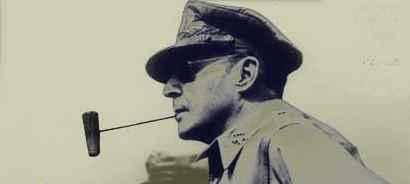THE SACRIFICE
OF BATAAN
 |
 |
BATAAN and CORREGIDOR |
"Dougout Doug" whom Truman called "a common coward" |
 |
 |
BATAAN and CORREGIDOR |
"Dougout Doug" whom Truman called "a common coward" |
The loss of the Philippines was the greatest defeat of the United States Army but it has not received the attention that such distinction deserves. How was it possible, with perfect knowledge of the enemy's plans and greatly superior forces, that the U.S. lost a strong defensive position?
There were four critical steps. (1) The U.S. bombers were sacrificed on the ground. (2) MacArthur prevented food, ammunition, gas and other supplies from being stored on Bataan. (3) The remaining U.S. airforces were sent away December 17 just as the main Japanese force approached in convoy without air-cover. (4) Forces had to be misplaced at Lingayen Gulf.
On 24 January 1942, Bataan was ordered to send food to the already well-stocked Corregidor which had a six-months supply for 10,000 men. The men on Bataan were starving. This order was to further reduce them. *4
On February 23rd FDR made a radio address to the troops on Bataan to discourage them and inform that they would receive no relief. While Soviet Communists were being rushed billions of dollars of supplies, nothing, not even food, could be spared our men on Bataan. They were left to starve and rot. This is in stark contrast to what happened on Guadalcanal just a few months later. There submarines and fast destroyers supplied our forces and even tankers full of gasoline were sent in and grounded so the troops could be well stocked. It would have been easy to break the "paper blockade", as MacArthur called it, around the Philippines especially since we were reading the Japanese fleet code and could avoid interception. Not only submarines could have supplied Bataan, and the Asiatic Fleet stationed at Manila had the largest submarine force in the U.S. Navy, but large supply ships could have stood off in the south islands and fast coast-runners could have brought the supplies to Bataan at night. MacArthur wrote, "Since the blockade was lightly held, many medium-sized ships could have been loaded with supplies and dispatched along various routes. It seemed incredible to me that no effort was made to bring in supplies." Japanese records show that commanding General Homma, who had about half as many troops as MacArthur, was ready to give up: "If only help could have reached the Philippines, even in small form, if only limited reinforcement could have been supplied, the end could not have failed to be a success." (It is incongruous for MacArthur to complain about lack of supplies when he was responsible.) Obviously, since ships were frequently sent out from Corregidor and Bataan in the spring of 1942, MacArthur himself leaving with a flotilla of PT boats on March 11, ships could have equally well have been sent in. However, saving the 31,095 Americans on Bataan was not going to happen - it was the last thing Roosevelt wanted. Some clue to his thinking was his suggestion of surrender to MacArthur rather early on in February, "I authorize you to arrange for the capitulation of the Filipino elements of the defending forces..." This discloses intent. This was at a time when President Quezon controlled seventy-five percent of his country, the Japanese really only controlled the cities and the Japanese general was ready to give up. MacArthur did not think it was a good idea partly because Roosevelt, in typical fashion, had worded his letter so that MacArthur would take the blame. *5
With perfect timing, Washington ordered all bombers to Australia on December 17th just as the invasion forces embarked. It was vital to prevent the American bombers from wreaking havoc on this invasion force when in their vulnerable transports. As it was, the Philippine Army greatly outnumbered the Japanese and there was danger of strong resistance, particularly in light of the marked inferior quality of Japanese artillery and tanks. To give some idea of the devastation that heavy strategic bombers would have caused to the Japanese transports, MacArthur mentions that of the twelve transports that approached the Philippines on December 10 (after Clark had been wiped out), four were sunk and three damaged. The horrific slaughter our bombers would have wreaked on defenseless transports is almost unimaginable. The invasion would have been a total debacle.
The defense of the Philippines cannot be understood in terms of conventional military strategy. In those terms it was one incomprehensible blunder after another, done with due deliberation and afterward profusely rewarded. Just as Clauswitz said war is politics by other means, the sacrifice of the Philippines can only be understood in the larger political context. Analysis of local decisions by MacArthur, miss the point that FDR was actually calling the shots. His motivations, not MacArthur's are at issue. The sacrifice of the 31,095 Americans and 80 thousand Filipino troops with 26 thousand refugees on Bataan is a separate issue from the sacrifice of the Army Air Corps at Clark and Iba.
The bombers were sacrificed, not only to facilitate the loss of the Philippines, but more immediately to sucker Hitler into declaring war on the United States and events in the Philippines are analogous to Pearl Harbor which happened the same day. However, Hitler did declare war on December 11th and therefore obviously the sacrifice of Bataan proper springs from other motives. To understand Roosevelt's strategy we have to ask a very basic question: Cui bono? "Who benefits?" Who benefited from Japan's temporary ascendancy and the war dragging on? It was obvious that when the Japanese Empire collapsed that there would be a power vacuum in Asia. The ultimate question of the Pacific War was who would fill that vacuum. Who would take China? Roosevelt wanted Russia to fill the vacuum (cf. his actions at Yalta and How the Far East Was Lost, Dr. Anthony Kubek, 1963) and therefore had to prolong the war so the Soviet Union could pick up the pieces. Because the Soviet Union had its hands full fighting Germany and could not dominate Asia until the war in Europe was under control, delay in the defeat of Japan was necessary. Bataan was a pawn in a larger game. The Battling Bastards of Bataan never understood enough to ask the critical question - "who was their real enemy?" It was Franklin Roosevelt.
The orders to fight on all beaches and not supply Bataan were nothing less than the deliberate sacrifice of 31,095 Americans.
1 Reminiscences, Douglas MacArthur, p 117. 2 "remove immediately", Philippines the Continuing Past, R. and L. Constantino, page 46. 3 American Ceasar, William Manchester, knew he had to go to Bataan, p 196; Cabantuan, ibid, p 215; war plans ibid p 194; January 10, ibid, p 235; Supplies lost, 4th star, Blood, Tears and Folly, Len Deighton, pp 570, 571; fish, Our Last Ditch, John Whitman, 1990. pp 46-47. 4 The Continuing Past, R. and L. Constantino, p 46. 5 Reminiscences, MacArthur, p 133, 128; Guadalcanal contrast, Oil and War, Robert Goralski and Russell Freeburg, p 157; FDR to MacArthur, Reminiscences, p 139. 6 No air cover - Fall of the Philippines, Louis Morton, 1953, official Army History, p 128.
 Pearl Harbor, Mother of All Conspiracies, the book <--click here to buy paperback (424 explosive pages) for only $16 or to buy ebook.For further information on the Sacrifice of Bataan and FDR's motives get the whole story. More Info on book
Pearl Harbor, Mother of All Conspiracies, the book <--click here to buy paperback (424 explosive pages) for only $16 or to buy ebook.For further information on the Sacrifice of Bataan and FDR's motives get the whole story. More Info on book
Books may be ordered: online: http://www.xlibris.com/PearlHarbor.html email: orders@xlibris.com by fax: (215) 923-4685 by telephone: 1-888-795-4274 x.276 by mail: Xlibris Corp. 436 Walnut St. 11th Fl. Philadelphia, PA 19106
 Battling Bastards of Bataan, "No Mama, No Papa, No Uncle Sam"
Battling Bastards of Bataan, "No Mama, No Papa, No Uncle Sam"
To more fully understand the motives of the man who sacrificed Bataan, see FDR Scandal Page by me 
and Communism at Pearl Harbor by Dr. Anthony Kubek.
See also General George C. Marshall
Pearl Harbor - Mother of All Conspiracies
Legal Reform | Education Reform | Secession Amendment |
The War Between the States | Zoroastrianism |
E-mail Mark Willey: pha1941@hotmail.com.
  This World War II Web Ring site is owned by This World War II Web Ring site is owned byMark Willey. Want to join the World War II Web Ring? |
|---|
| [Skip Prev] [Prev] [Next] [Skip Next] [Random] [Next 5] [List Sites] |